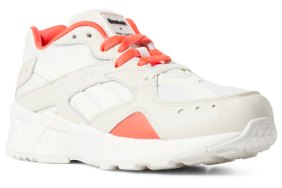If you’ve turned on your TV at any point these past few months, odds are that you have seen a tantalizing commercial for Reebok’s latest innovation, EasyTone. With models and celebs like Miranda Kerr, Marisa Miller, and Kendra Wilkinson all proudly donning the shoes, I was curious to learn more about the technology behind these exciting kicks.

McInnis, who now heads up the Advanced Innovation division at Reebok, spent 18 months perfecting a balance pod system in the sole of the shoe that creates natural instability with each step. This not only resulted in dramatic improvements when tested in the lab, but the design was such that it could be worked into a shoe without compromising the look.

The first thing on my mind when speaking with the innovator was how and why he made the transition from NASA to Reebok. McInnes explained that, while the transition wasn’t a common one, he didn’t see himself as passionate about NASA as some of the people he worked with. He added that many of the characters portrayed in the space films that we’re all so familiar with are still active employees decades after first joining NASA. Of course, the demand for rocket scientists is rather limited, so McInnis went back to school and got his MBA before joining Reebok, where he says, as someone passionate about science and athletics, he has found his true career match.

While McInnis mostly works on the latest and greatest innovations, for the average person, buying a sneaker can be a somewhat overwhelming task given the endless options on the marketplace. When looking for a sneaker, McInnis advices to first and foremost pay attention to fit – “People need to be aware that what’s right for everyone else may not be right for them. People buy shoes by size or appearance, but you really need to put them on and wear them.” He added that in addition to looking for a shoe that fits, if you’re looking to be active from an athletic standpoint, make sure the shoe matches what you’ll be doing, whether it be running, walking, basketball, etc.
Hearing McInnis discuss the various types of sneakers and how people tend to shop for them reminded me a lot about the way people shop for hair care products. Most people blindly buy based on smell, thus negating all the research that goes into making one hair product better for one hair type over another. Similarly, there is a science behind the various shoe types, and given how the way you move is so drastically different depending on what you’re doing (height, landing angle), one really needs to look at what the shoe was engineered for and compare it to what you will be using it for. McInnis added that “what a professional athlete does is very different from what someone who is just casually doing the sport does,” so just because you do 10 different types of physical activity doesn’t necessarily mean you need a different shoe for each and every one.

Moving away from athletics, the EasyTone is engineered as a walking shoe, making it ideal for those with active lifestyles. For someone who lives in a city like New York City and walks almost everywhere, the shoe is a great way to get an extra benefit at no extra cost.
“No, you wouldn’t want to play tennis in it because of the micro instability built into the shoe,” McInnis remarks, “But the EasyTone can become part of your overall fitness program. It’s meant to augment whatever resistance, strength, cardio, or other form of workout that you already do. The beauty of this shoe is that you can walk around as you normally would, but get all these extra benefits.”

The interview capped off with an inquiry about what we can expect next from McInnis and his team.
Given how well the shoe has been performing – McInnis noted that retail-wise it’s flying off the shelves in a way they haven’t seen in 10 years – come Spring 2010, the line will be branching out into shoes that offer stylish, effective ways to tone for those engaging in activities other than walking.








